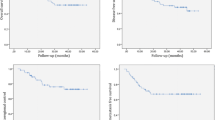Abstract.
The aim of this study was to evaluate the possible usefulness of fluorine-18 fluorodeoxyglucose positron emission tomography (FDG-PET) for predicting tumour aggressiveness and response to intra-arterial chemotherapy (THP-ADM + 5-FU + carboplatin) and radiotherapy in head and neck carcinomas. Twenty patients with squamous cell carcinoma (SCC) of the head and neck were included in the study. All patients completed the treatment regimen, and each patient underwent two FDG-PET studies, one prior to and one at 4 weeks after the chemoradiotherapy. For the quantitative evaluation of regional FDG uptake in the tumour, standardised uptake values (SUVs) with an uptake period of 50 min were used. The pre-treatment SUV (pre-SUV) and post-treatment SUV (post-SUV) were compared with immunohistologically evaluated tumour proliferative potential (MIB-1 and PCNA), tumour cellularity and other parameters including histological grade, tumour size and stage, clinical response and histological evaluation after therapy. All neoplastic lesions showed high SUVs (mean, 9.75 mg/ml) prior to the treatment, which decreased significantly after the therapy (3.41 mg/ml, P<0.01). Pre-SUV did not show any correlation with MIB-1, PCNA, cellularity or other parameters. However, lower post-SUV was significantly correlated with good histological results after therapy (no viable tumour cells, n=16). In comparison with moderately differentiated SCCs, well-differentiated SCCs exhibited significantly lower post-SUV and a larger difference between pre- and post-SUVs. Lesions with a high pre-SUV (>7 mg/ml) showed residual tumour cells after treatment in 4 out of 15 patients, whereas patients whose lesions showed a low pre-SUV (<7 mg/ml, five patients) were successfully treated. Four out of six tumours with a post-SUV higher than 4 mg/ml had viable tumour cells, whereas all tumours (14/14) with a post-SUV lower than 4 mg/ml showed no viable tumour cells. Computational multivariate analysis using multiple regression revealed four factors (MIB-1 labelling index, cellularity, the number of MIB-1 labelled tumour cells and tumour size grade) contributing to pre-SUV and pre-post SUV (difference between pre-treatment SUV and post-treatment SUV in each patient) with statistical significance. FDG uptake in the tumour might reflect tumour aggressiveness, which is closely related to the proliferative activity and cellularity. Pre-treatment FDG-PET is useful in predicting the response to treatment, and post-treatment FDG-PET is of value in predicting residual viable tumours. FDG-PET has a profound impact on the treatment strategy for head and neck carcinomas.
Similar content being viewed by others
Author information
Authors and Affiliations
Additional information
Electronic Publication
Rights and permissions
About this article
Cite this article
Kitagawa, Y., Sano, K., Nishizawa, S. et al. FDG-PET for prediction of tumour aggressiveness and response to intra-arterial chemotherapy and radiotherapy in head and neck cancer. Eur J Nucl Med 30, 63–71 (2003). https://doi.org/10.1007/s00259-002-0978-z
Received:
Accepted:
Issue Date:
DOI: https://doi.org/10.1007/s00259-002-0978-z




